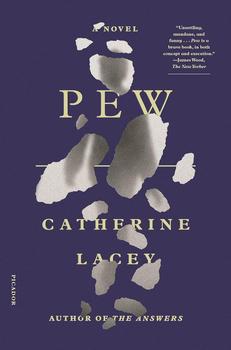Summary | Excerpt | Reviews | Beyond the Book | Read-Alikes | Genres & Themes | Author Bio

This article relates to Pew
 In Catherine Lacey's novel Pew, the title character is given their name because they are found sleeping on a church pew. The word "pew" is thought to come from the Dutch "puye," meaning the enclosed front area of a building such as a town hall, where important proclamations were made. "Puye," in turn, may come from the Latin word "podium." Samuel Johnson's A Dictionary of the English Language, first published in 1755, defined a pew as "a seat enclosed in a church."
In Catherine Lacey's novel Pew, the title character is given their name because they are found sleeping on a church pew. The word "pew" is thought to come from the Dutch "puye," meaning the enclosed front area of a building such as a town hall, where important proclamations were made. "Puye," in turn, may come from the Latin word "podium." Samuel Johnson's A Dictionary of the English Language, first published in 1755, defined a pew as "a seat enclosed in a church."
Wooden pews as we know them today first became widespread in Europe in the 1500s following the Protestant Reformation. Before that, church floors were usually kept bare because the congregation stood during services. Some churches kept moveable, backless stone benches around the walls for the elderly to sit on. Eventually, these started to be fixed to the floor, and stone was replaced with wood. Some of the oldest pews still standing are from the early 1600s.
Pews made it possible for parishioners to sit during the lengthy sermons typical of Protestant services. Catholic churches later followed the Protestant lead to an extent, introducing pews and allowing people to sit for parts of the Mass. Although church services had previously been more interactive, this new format, with pews set up in rows facing the pulpit, was arguably more inclusive of churchgoers, acknowledging the importance of their presence as listeners.
Pews came to be seen as tokens of social status across denominations: The wealthy sat near the front, while the poor sat further back. Before the mid-19th century, it was common for churches to sell or rent pews. Powerful families purchased box pews and considered them their personal property, to be handed down in wills. Free pews were often available at the back for the poor and for church visitors. Churches in the United States also employed "slave galleries," or rooms in the back of the church for keeping enslaved people separated from the rest of the congregation.
Starting in the 1840s, pew rental became contentious in the Anglican church. Citing ethical concerns, many Anglican churches outlawed the policy by the 1870s and instituted open seating instead. Some pew rental still continued into the 20th century, particularly in Catholic and Presbyterian churches in the United States, which relied on the practice for income, but it was mostly phased out by the late 1940s.
Nowadays, some churches are replacing their pews with chairs so that they have more flexible spaces. For instance, last year Bath Abbey sold off its Victorian pews in favor of lightweight, stackable chairs that can be moved to prepare for community events such as concerts and exhibits. Although it's a common move for English churches, it's a controversial one, with many claiming that it spoils the architectural integrity of such historic buildings.
Illustration of church pews from Milford Malvoisin, or Pews and Pewholders (1842) by Francis Edward Paget
Filed under Cultural Curiosities
![]() This "beyond the book article" relates to Pew. It originally ran in August 2020 and has been updated for the
July 2021 paperback edition.
Go to magazine.
This "beyond the book article" relates to Pew. It originally ran in August 2020 and has been updated for the
July 2021 paperback edition.
Go to magazine.






Your guide toexceptional books
BookBrowse seeks out and recommends the best in contemporary fiction and nonfiction—books that not only engage and entertain but also deepen our understanding of ourselves and the world around us.